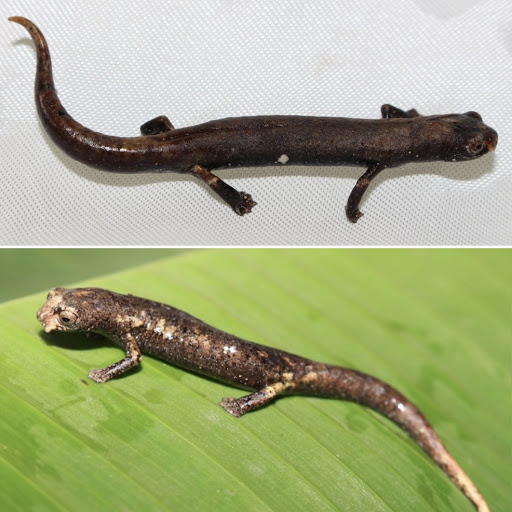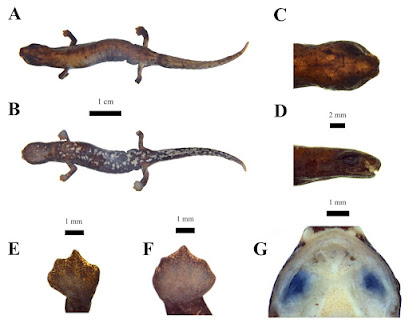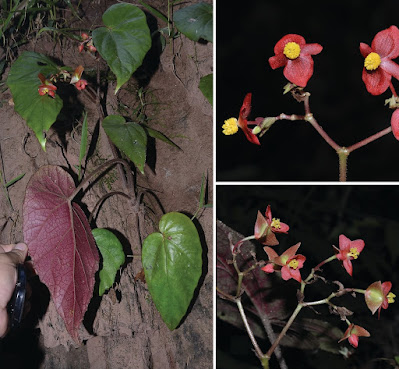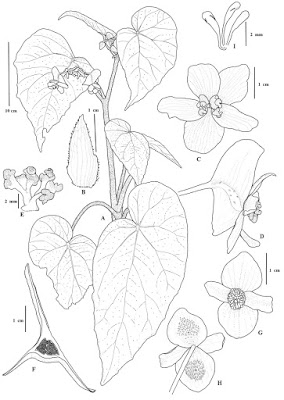[Most Recent Entries] [Calendar View]
Friday, August 21st, 2020
| Time | Event | ||
| 3:27a | [Herpetology • 2020] Bolitoglossa awajun • Taxonomic Status of the Neotropical Salamanders Bolitoglossa altamazonica and B. peruviana (Caudata: Plethodontidae), with the Description of A New Species from Northern Peru
Abstract We examine the phylogenetic relationships among salamanders of the genus Bolitoglossa (Eladinea) distributed in the Amazonian basin of northern Peru and southern Ecuador and assess species diversity based on morphological and phylogenetic analyses. We infer a molecular phylogeny using sequences from two mitochondrial (Cytb, 16S) and two nuclear genes (RAG–1, POMC). We find two well-supported subclades, one including [B. altamazonica + B. peruviana] + B. awajun sp. n., and the other including Bolitoglossa sp. Ituxi + Bolitoglossa sp. Jurúa. Ecuadorian lineages form divergent clades from the Peruvian lineages. Accordingly, Ecuadorian populations previously assigned to Bolitoglossa peruviana sensu lato are treated as members of a Bolitoglossa equatoriana species complex. A newly defined Bolitoglossa altamazonica species complex contains only populations from the Amazonian rainforest of Peru. Maximum likelihood and Bayesian Inference analyses confirm the phylogenetic placement of B. altamazonica and B. peruviana, and support recognition of a related new species of Bolitoglossa. The uncorrected genetic distances between the new species and B. altamazonica are 6.5% for Cytb and 4.9% for 16S; and the uncorrected genetic distances between the new species and B. peruviana are 8.0% for Cytb and 3.9% for 16S. Additionally, analyses of nuclear gene sequences show no haplotype sharing between the new species and closely related species. The new species is distinguished from its congeners by a combination of the following morphological characters: (1) Standard length mean 37.7 mm in males (range 32.0–42.2; n=5) and 41.4 mm in females (range 34.9–48.2; n=6); (2) in life, dorsal coloration uniformly brown with a dark brown triangular marking between the eyes or some irregular light cream spots or patches on the head, back and flanks; (3) iris pale golden; (4) in preservative, dark brown venter with cream mottlings or moderate-sized blotches on the gular region, belly, cloacal region and tail; (5) tips of third finger and third toe protuberant and pointed with nearly complete webbing on the hands and feet; (6) 11–26 maxillary teeth and 8–24 vomerine teeth. Given that the syntypes of B. altamazonica are lost, we designate a neotype for B. altamazonica from Allpahuayo Mishana National Reserve, Loreto department, Peru. Newly collected specimens from ~30 km NE from Moyobamba (type locality of B. peruviana) provide a better understanding of B. peruviana and enable us to show that it is the sister taxon of B. altamazonica. The new species is known from pre-montane forests in Cordillera Escalera Regional Conservation Area, Cordillera Azul National Park and Shucshuyacu, San Martin department, Peru at 485–1311 m elevation, ~75 km SE from Moyobamba. Bolitoglossa awajun sp. n. is the fourth endemic species of salamander from Peru. Keywords: Amphibia, Bolitoglossa awajun sp. n., subgenus Eladinea, morphometrics, DNA sequences, Amazonia Bolitoglossa awajun sp. n. Suggested English name: Awajun salamander Suggested Spanish name: Salamandra Awajún Etymology: The specific epithet awajun refers to the Peruvian ethnic group known as “Awajún” or “Aguaruna” native inhabitants of Amazonian rainforests in Loreto, Amazonas, San Martin and Cajamarca departments. The name is treated as a noun in apposition. Juan C. Cusi, Giussepe Gagliardi-Urrutia, Isabela Carvalho-Brcko, David B. Wake and Rudolf von May. 2020. Taxonomic Status of the Neotropical Salamanders Bolitoglossa altamazonica and Bolitoglossa peruviana (Amphibia: Caudata: Plethodontidae), with the Description of A New Species from Northern Peru. Zootaxa. 4834(3); 365–406. DOI: 10.11646/zootaxa.4834.3.3 | ||
| 3:57a | [Botany • 2020] Begonia colliculata (Begoniaceae: Section Platycentrum) • A New Species from Nam Kading National Protected Area, Bolikhamxai Province, Laos
ABSTRACT Begonia colliculata is described and illustrated with photographs from Nam Kading National Protected Area, in the Bolikhamxai Province of Laos. Keywords: Begonia, Biodiversity, Laos, new taxon, taxonomy Begonia colliculata Souvann. & Lanors., sp. nov. (Section Platycentrum). Begonia colliculata is similar to Begonia hekouensis S.H.Huang, but differs in having ver-rucous peduncles (vs densely villous), bracts with a strigose margin (vs ciliate), sparsely strigose tepals (vs villous), a sparsely strigose and colliculate ovary with a broadly falcate-elongate dorsal wing (vs densely purplish brown villous and not colliculate, dorsal wing ligulate). It is also similar to B. croceaC.-I Peng but differs in having a cane-like stem (vs stemless), leave blade ovate-lanceolate (vs broadly ovate), inflorescences arising from axils on the stem (vs arising directly from the horizontal rhizome) and anthers elliptic-oblong, apex rounded (vs fusiform-obovate, apex acuminate) (Table 1). Entomology.— The specific epithet “colliculata”refers to the colliculate surface of the ovary and fruit. Vernacular.— ສົ້ມກຸ້ງແດງ - Som koung deang (Red begonia). Keooudone Souvannakhoummane, Soulivanh Lanorsavanh, Jeong Ho Park, Ho Sang Kang, Tai Hyeon Ahn, Singkone Xayalath and Chanhsamone Phongoudom. 2020. Begonia colliculata (Begoniaceae), A New Species from Nam Kading National Protected Area, Bolikhamxai Province, Laos. Thai Forest Bulletin (Botany). 48(2); 108-113. DOI: 10.20531/tfb.2020.48.2.04 |
| << Previous Day |
2020/08/21 [Calendar] |
Next Day >> |










